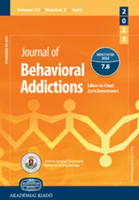Validation of the Ten-Item Internet Gaming Disorder Test (IGDT-10) based on the clinical diagnosis of IGD in Japan
Validation of the Ten-Item Internet Gaming Disorder Test (IGDT-10) based on the clinical diagnosis of IGD in Japan
Author(s): Satoko Mihara, Yoneatsu Osaki, Aya Kinjo, Takanobu Matsuzaki, Hideki Nakayama, Takashi Kitayuguchi, Takayuki Harada, Susumu HiguchiSubject(s): Social psychology and group interaction, Developmental Psychology, Personality Psychology, Clinical psychology, Behaviorism
Published by: Akadémiai Kiadó
Keywords: Internet gaming disorder; Ten-Item Internet gaming disorder Test; scoring; validation; cutoff; estimated rate; Japan;
Summary/Abstract: Although the Ten-Item Internet Gaming Disorder Test (IGDT-10) has been translated into Japanese and widely used, the Japanese version has not previously been validated. We used the clinical diagnosis of IGD as a gold standard for validating the test. Methods: The Japanese version was validated using 244 gamers drawn from the general young population in Japan. Expert interviews using the Japanese version of the Structured Clinical Interview for Internet Gaming Disorder evaluated diagnoses of Internet gaming disorder (IGD). This resulted in a diagnosis of IGD for eight individuals, categorized as the gold standard group. The screening performance of the two Japanese versions with different scoring conditions was examined: the scoring method proposed by the original study (original version) and a less stringent scoring method where responses of either “often” or “sometimes” were regarded as affirmative (modified version). Results: The results of the sensitivity and specificity analyses, the Cronbach’s alpha and the receiver operating characteristics analysis revealed a higher screening performance for the modified versus the original version. The optimum cutoff for the modified version was 5 or more – the sensitivity, specificity, and Youden’s index were 87.5, 85.2, and 72.7%, respectively. The rate of probable IGD using the original and modified versions were 1.8% and 11.3%, respectively. Discussion and conclusion: A less stringent scoring method for the Japanese version of IGDT-10 showed a higher screening performance than the original scoring method. Future studies comprising different ethnic groups and gaming cultures should further examine the suggested scoring method.
Journal: Journal of Behavioral Addictions
- Issue Year: 11/2022
- Issue No: 4
- Page Range: 1024-1034
- Page Count: 11
- Language: English

